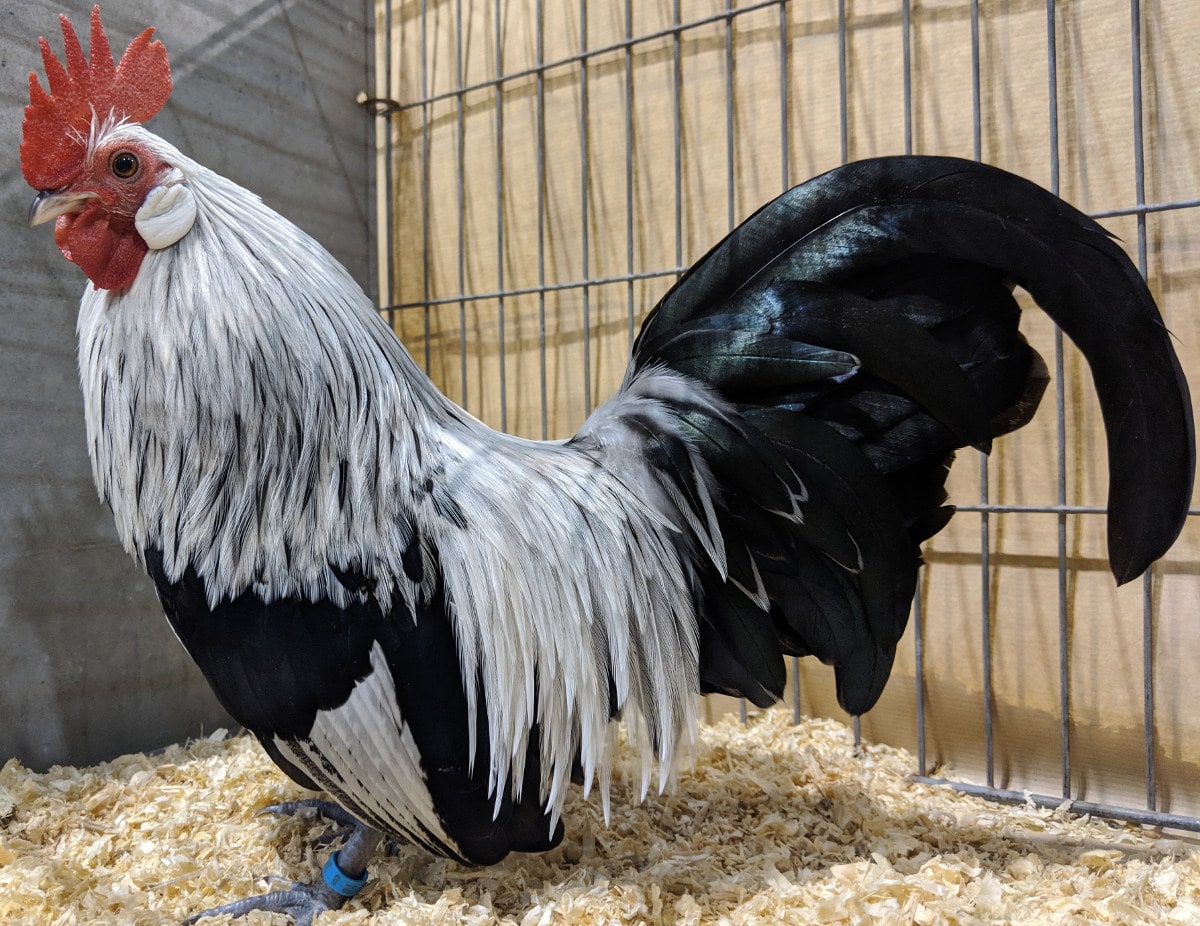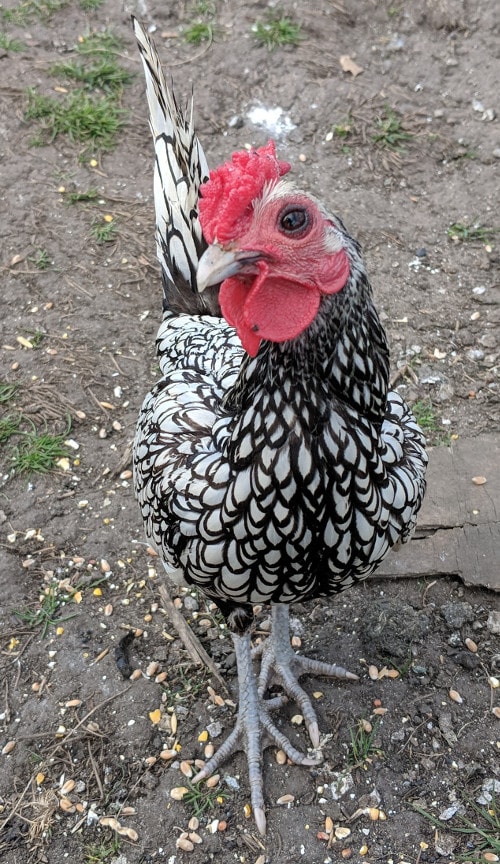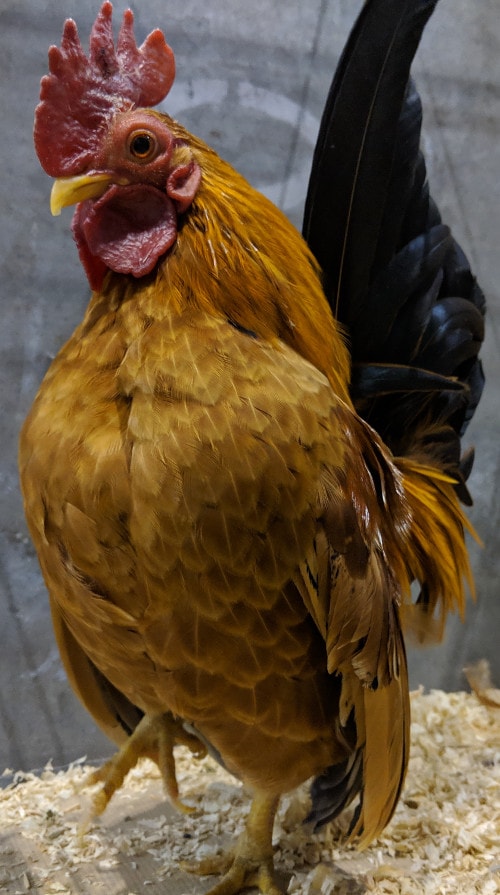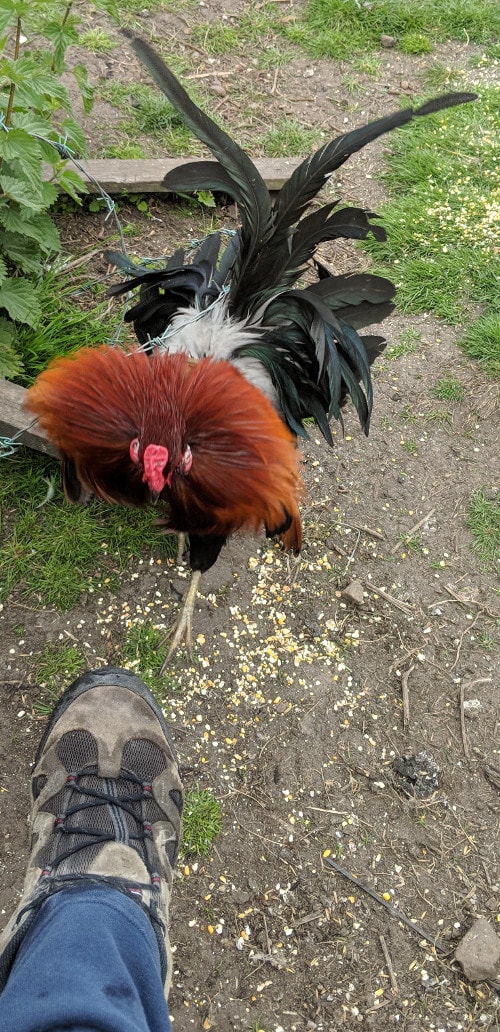Bantam roosters and cockerels

What Is A Bantam Rooster?
Bantam Roosters are miniature versions of regular chickens that we chicken keepers come across almost on a daily basis. They are smaller in size and in most cases they are around 30% of 50% the size of regular chickens.
There are a few things that make them unique and different. They are cute to look at and are popular for their feather and colourful plumage.
Below: Say hello to Goliath, my silver Sebright rooster. As friendly as a puppy.

They help make your backyard colourful while not taking up to much room. Many keepers prefer keeping smaller chickens as pets in place of large chickens.
Though they are small in size when compared to regular large fowl chickens, they are known for the big personalities.
Many chicken keepers believe that it is not advisable to keep roosters in homes where there are children but as long as you are careful and don't leave the children unattended with unknown cockerels it shouldn't be an issue.
If they are reared and handled properly they can make great pets. Let us therefore learn something more about the behaviour of these roosters and learn more about these beautiful birds.
How big are bantam roosters?
Bantam roosters can weight from as little as 400 grams for the little Serama to around 1100 g or just over a kilogram for the Brahma bantam. The height can be anything from 8 inches for the Serama to 16 inches or even a little more for the tallest birds.
Below: The Serama is the smallest chicken.

What is the difference between a rooster and a cockerel?
When I was just starting out I asked this very same question of my mentor.
He said " A cockerel is any young male and a rooster is any male chickens that has his own hens to roost with"
Things were a little different in his day as any surplus male would have ended up as Sunday lunch
Are Bantam Roosters Aggressive?
Bantam rooster are only small in your mind, in their mind they are the same size as their opponent.
Bantam roosters are no more aggressive than their large fowl counterparts. Some of them like the Japanese bantam always seem to be docile and good natured. They do have added advantage of being small in size and a bit easier to control.
They can be, if compared to the hens in your flock, cockerels or roosters are known for their aggressive behaviour.
For most of the owners, raising bantam roosters is almost the same as bringing up any full sized chicken. As mentioned above, they are smaller in size and this perhaps is the only difference.
Below: This is Tiddles, one of my bantam roosters, and you can't turn your back on him for a second. Anybody or anything is fair game to him.

That said he is the only real monster I have and I have 36 cockerels at the moment.
There are many homes where these bantams are kept together with other full sized chickens. They do not seem to create too much of a problem. However, there are few instances where the Bantams exhibit aggressive behaviour and we should know how to handle such situations.
Larger regular chickens can injure the bantams in their effort to mate with them.
Sometimes their ability to fly well is often mistaken as aggressive behaviour. They are notorious for escaping and can get away from small holes in fences or even through cracks in the gates.
Yes they can at times be aggressive but they are so small in size that they can hardly do too much of damage. However, it would be advisable to keep them away from children especially when you believe that a particular bantam is aggressive in its behaviour. You could learn to cuddle it, feed it by hand and then hope for the best.
Bantam breeds I have kept in the past that are known to be docile:
- Japanese bantams.
- Polish bantams.
- Dutch bantams.
- Silkies.
Do Bantam Roosters Fight?
Though some roosters are quite well behaved and can stay together with other roosters, there have been many instances where they have exhibited aggressive behaviours, especially when they are kept with other breeds. I have had the odd rooster that was just a bully and fought all the time.
In many cases they do not know how to behave even if the conditions are perfect and ideal. Some breeds of bantam roosters are known to exhibit aggressive behaviour, this is a hang over from the days when some breeds were bred especially to fight for sport.
They are known to fight amongst one another and also with other breeds. For example, there are some game breeds of roosters that are known for their feisty nature.
Below: Here is two bantam roosters sparring:
These two are just messing about in a trial of strength. A proper fight between two roosters often goes on for ages and can be terminal for one or both.
I have 2 examples from over the years I have had bantams, My Marans and Rhode Island Reds were notorious for being extremely aggressive in their behaviour and taking on just about everything else.
More often than not, the bantams that pick fights with large fowl mostly end up being on the losing side because they are much smaller in size.
Also don't confuse daily squabbles with true fighting, one happens all the time and rarely results in more that a bit of screaming and the odd pulled feather and true fighting which can last 20 minutes or more and result in one killing the other.
Do Bantam Cockerels Crow?
The bantam males might be known for their big attitude and feisty behaviour, they do not however, have a big crow. In my experience crowing is more breed dependant that anything else, my Orpingtons hardly ever crow where as some breeds never seem to stop.
If they do crow more frequently it is in most cases more high pitched but quieter overall. Hence, it is surprising that there is a mismatch between their aggressive behaviour and the meek way in which they crow.
When they are kept together with other roosters, their crowing often drowns when compared to other roosters. Therefore, we can conclude by saying that though cockerels do crow a lot, their crowing perhaps lacks the strength and boom that is often associated with their attitude and behaviour.
How Long Do Bantams Cockerels Live?
On average bantam cockerels live 8 years . There are many factors that determine the lifespan of a bantam chicken. These include the breed, the environment in which they are made to grow and the kind of water and feed that they are fed.
While some breeds tend to live longer, some are not so hardy. There have been instances where a few of these bantam cockerels and roosters have lived beyond eight years. However, they are subject to illness and they should be carefully handled and reared.
Some breeds have a life span of just around four years. On an average the life span of these breed of roosters and cockerels ranges from four years to eight years. There are some rare instances where they have lived beyond ten years.
Hence, if you want to increase the life span of these beautiful birds, there are a few obvious things that one should bear in mind. Ensure that they get quality water and feed.
Make sure that the feeds have the right nutrients.
Avoid keeping them close to dirty water because that could lead to bacterial infections and parasites could weaken them significantly. These can easily kill these birds when they are chicks.
Keeping multiple roosters in A flock:
In general with most breeds of chickens you’ll only want to keep 7-12 hens for each rooster.
Below: Here is my flock of bantam Barnevelders and there are two roosters in with 9 hens and they get along just fine.
If you plan a flock of 20 hens then 2 roosters is perfect. When they are young, roosters can attend to more hens but as they get older, too many hens will result in low fertility. Too few hens result in tired out, torn up hens and roosters who fight with each other.
Here’s the secret to keeping more than one rooster; raise them together from a very young age.
I have kept 4 roosters in a flock a large flock before and I was thrilled to see that the four roosters did just fine together! They had their own pecking order with the dominant fellow doing most of the crowing. They really didn’t squabble much at all because they had worked out issues of submission.
They did so well because they were all brothers and had never known life without the others. I’ve heard other people say this as well.
In fact that’s the way it seems with most animals; if they are raised with a particular circumstance, they are accustomed to it.
Conclusion:
They add quite a bit of character and colour to your backyard coop and generally make very good pets.
Yes, there are some problems with their attitude and behaviour. You should be alert and alive to this situation and do what it takes to keep them in good humour. There are some precautions that should be taken. For example, it would always be advisable to keep the bantam roosters and cockerels away from children.
Further, if you find their attitudes and behaviours very aggressive, it may be advisable to keep them separate from other breeds of chickens, roosters and cockerels. They are also good flyers and therefore ensure that the enclosures are sealed and kept in good condition.
